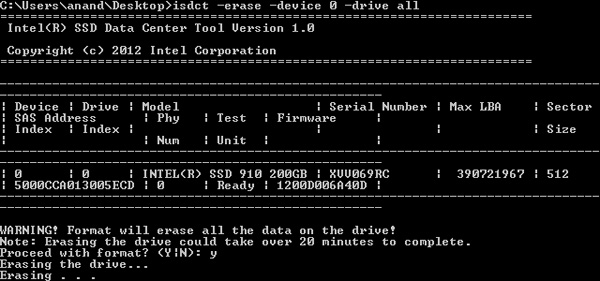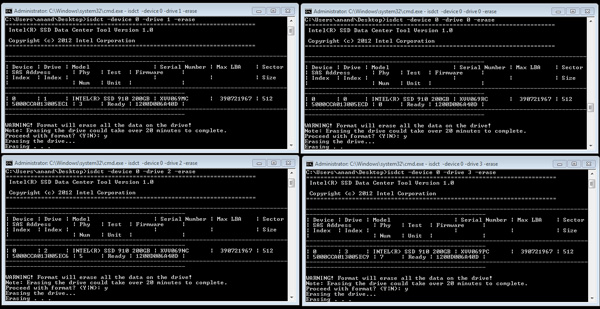The Intel SSD 910 Review
by Anand Lal Shimpi on August 9, 2012 1:00 PM EST- Posted in
- Storage
- SSDs
- Intel
- Intel SSD 910
Intel's SSD Data Center Tool
Despite Intel's wonderful desktop SSD toolbox, there's a more powerful but less user friendly option for the 910. It's called the Intel SSD Data Center Tool (isdct for short) and it's driven entirely by the command line. The tool is available for both Windows and Linux. You can use the isdct to secure erase the 910:
Each controller/partition must be secure erased independently, or in tandem by running four copies of isdct:
Since each partition is effectively an independent drive, you can run multiple isdct commands and just target a different drive with each instance. The isdct is also how you monitor temperatures on the individual drives, once again you have to execute a command per drive to get the temperature of that drive. Under Windows you need to execute the following command:
isdct.exe –log 0x2F –drive <drivenum> -device <devicenum> -verbose
Then look at the value of byte 10, which will tell you the current temperature...in hex. Convert back to decimal and you'll have the temperature of the specified NAND partition in degrees C. I have to admit I found all of this a bit endearing (I never get to read temperatures in hex), but your system administrator may be less impressed. Thankfully it shouldn't be all that difficult to script the isdct to quickly give you the data you want, even at regular intervals. The tool exposes quite a bit and since it's entirely command line driven it's pretty easy to automate, but I can't help feel like Intel should at least do some of this for you. I appreciate the flexibility, but others may want something a bit simpler.
Other than obsessively monitoring temperatures (I never saw a temperature higher than 1F, 37 is the operational limit) and secure erasing the drives, I used the isdct to switch between performance modes on the 910:
Remember the 400GB drive always runs in this max performance mode, but the 800GB drive must be forced into it. You get a warning about the increased cooling and power requirements (up from 25W max TDP and 200 LFM cooling requirement) but otherwise the process is painless.













39 Comments
View All Comments
JellyRoll - Friday, August 10, 2012 - link
WOW. low QD testing on an enterprise PCIe storage card is ridiculous. End users of these SSDs will use them in datacenters, and the average QD will be ridiculously high. This evaluation shows absolutely nothing that will be encountered in this type of SSDs actual usage. No administrator in their right mind would purchase these for such ridiculously low workloads.SanX - Friday, August 10, 2012 - link
and you do not need more then 16/32/64GB size for your speedy needs, then consider almost free RAMdisk with the backup. It will be 4-8x faster then this cardmarcplante - Friday, August 10, 2012 - link
It seems that there would be a market for a consumer desktop implementation.Ksman - Friday, August 10, 2012 - link
Given how well the 520's perform, perhaps a RAID with 520's on a LSI RAID adapter would be a very good solution and a comparison VS the 910 would be interesting. If RAID>0, then one could pull drives and attach direct for TRIM etc which would eliminate the problem where SSD's in a RAID cannot be managed.Pixelpusher6 - Friday, August 10, 2012 - link
I was wondering the exact same thing. What are the advantages of offering a PCIe solution like this compared to say just throwing in a SAS RAID card and connecting a bunch of SSD SAS drives in a RAID 0? Is the Intel 910 mainly targeted at 1U/2U servers that might not have space available for a 2.5" drive? Is it possible to over-provision any 2.5" drive to increase endurance and reduce write amplification (I think the desktop Samsung 830 I have allows this)? Seeing the performance charts I wonder how 2 of those Toshiba 400GB SAS drives would compare against the Intel 910.Is the enterprise market moving towards MLC-HET NAND with tons of spare area vs. SLC NAND because of the low cost of MLC NAND now since fabs have ramped up production? I was under the impression that SLC NAND was preferable in the enterprise segment but I might be wrong. What are some usage scenarios where SLC would be better than MLC-HET and vice versa?
I think lorribot brought up a good point:
"I like the idea but coming from a highly redundant arrays point of view how do you set this all up in a a safe and secure way, what are the points of failure? what happens if you lose the bridge chip, is all your data dead and buried?"
I wonder if it is possible to just swap the 1st PCIe PCB board with all the controllers and DRAM in case of a failure of the bridge chip or controller thus the data remains safe. Can SSD controllers fail? Is it likely that the Intel 910 will be used in RAID 0? I didn't think RAID 0 was used much in enterprise. Sorry for all the questions. I have been visiting this site for over 10 years and I just now registered an account.
FunBunny2 - Saturday, August 11, 2012 - link
eMLC/MLC-HET/foo-MLC are all attempts to get cheaper parts into SSD chassis, even for enterprise companies such as Texas Memory. Part of the motivation is yet more sophisticated controllers, and, I suspect, the realization that enterprises understand duty life far better than consumers (who'll run a HDD forever if it survives infant mortality). The SSD survival curve (due to NAND failure) is more predictable than HDD, so with the very much faster operations, if 5 years remains the lifetime, the parts used don't matter. The part gets swapped out at 90% or 95% of duty life (or whatever %-age the shop decides); end of story. 5 years ago, SLC was the only way to 5 years. That's not true any longer.GatoRat - Sunday, August 12, 2012 - link
"the 800GB 910 is easily the fastest SSD we've ever tested."Yet the tests clearly show that it isn't. In fact, the Oracle tests show it's a dog. In other tests, it doesn't come up on top. The OCZ Z-Drive R4 CM84 600GB is clearly the faster overall drive.
Galcobar - Sunday, August 12, 2012 - link
Grok!I'm impressed both to see the literary reference, correctly used, and that nobody has called it a typo in the comments. Not bad for a fifty-year-old novel once dismissed by the New York Times as a puerile mishmash.
a50505 - Thursday, August 30, 2012 - link
So, has anyone heard of a workstation class laptop that with a PCIe based ssd?